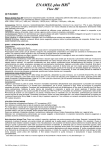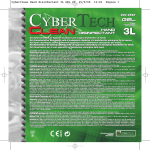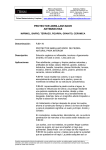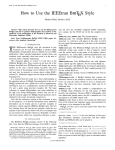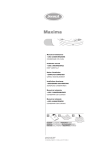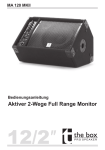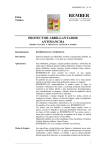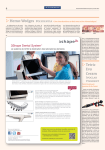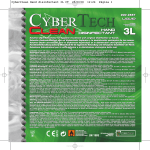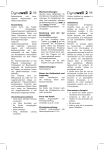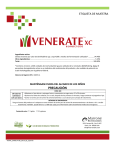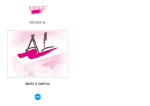Download impaginato_Layout 1
Transcript
impaginato_Layout 1 13.08.2013 15:43 Pagina 1 Istruzioni per l'uso Istrucciones de uso Phone +41 (0)91 946 29 48 Fax +41 (0)91 946 32 03 www.polydentia.com • [email protected] Adesivo dentale fotoindurente Via Cantonale 47 6805 Mezzovico-Vira • Switzerland 1) Denominazione del prodotto medico Fiber-Bond Made in Switzerland POLYDENTIA SA Swiss Products for Fine Dentistry Adesivo dentale fotoindurente. 2) Composizione Bis-GMA, TEGDMA, dodecandiol-dimetacrilato, HPMA, Butandiol-dimetacrilato. Only for professional use 3) Indicazioni Come adesivo dentale (Bonding) per Fiber-Splint, Fiber-Splint ML e Fiber-Splint Ortho con tecnica della mordenzatura dello smalto, come umettante nell'uso di Fiber-Splint, Fiber-Splint ML, Fiber-Splint Lab Ret e Fiber-Splint Lab Bridge per riparazioni e/o rinforzo di resine dentali. Adhesivo dental fotopolimerizable 1) Descripción del producto medicinal Fiber-Bond Adhesivo dental fotopolimerizable. 2) Composición Bis-GMA, TEGDMA, Dodecandioldimetacrilato, HPMA, Butandioldimetacrilato. 3) Indicaciones Como adhesivo dental (Bonding) para Fiber-Splint, Fiber-Splint ML y Fiber-Splint Ortho con la técnica del grabado adamantino, como agente humectador en la aplicación de Fiber-Splint, Fiber-Splint ML, Fiber-Splint Lab Ret y Fiber-Splint Lab Bridge en reparaciones y/o refuerzos de resinas dentales. Adhesivo dental fotopolimerizable Adesivo dentale fotoindurente Adhésif dentaire photopolymérisable 4) Effetti collaterali Benché non siano stati osservati effetti tossici di Fiber-Bond alla polpa, non può essere esclusa l'irritazione della polpa in caso di contatto diretto di Fiber-Bond con la dentina. Lichthärtendes Dentaladhäsiv Light curing dental adhesive 5) Interazioni Preparati a base di eugenolo inibiscono la polimerizzazione. 6) Avvertenze Essendo Fiber-Bond sensibile alla luce blu, la polimerizzazione è attivata anche dalla luce diurna o artificiale (illuminazione del campo operatorio). Usando filtri di luce blu è possibile rallentare notevolmente tale processo. Pertanto si consiglia di esporre il materiale fotoindurente alla luce soltanto per il tempo strettamente necessario (prelevare il materiale solo nel momento dell'applicazione, richiudere i flaconi subito dopo il prelievo) e di applicarlo e modellarlo rapidamente. Directions for Use Gebrauchsanweisung Mode d'emploi Istruzioni per l'uso Instrucciones de uso REV. 01 07.2013 7) Applicazione I nastri di fibra di vetro (Fiber-Splint, Fiber-Splint ML, Fiber-Splint Ortho, Fiber-Splint Lab Ret, Fiber-Splint Lab Bridge) devono essere ben impregnati con Fiber-Bond. Il tessuto deve pertanto essere completamente pieno di liquido. Il nastro di fibra di vetro impregnato deve essere indurito con luce blu. L'indurimento della striscia in fibra di vetro (relativamente dell’adesivo dentale Fiber-Bond) dipende dalle prestazioni della lampada di polimerizzazione. Di norma, per un nastro della lunghezza di 1 cm è sufficiente un tempo di polimerizzazione di 20 secondi. Tuttavia, per assicurare l’uniformità, si raccomandano circa 30-40 secondi. Questa valutazione si basa sull’assunzione di un’intensità luminosa di circa 800 mW/cm ², che corrisponde all’ intensità usuale di lampade alla lunghezza di banda di 400-500 nm (luce blu). Per la polimerizzazione con luce LED, poiché molte unità LED emettono luce con lunghezza di banda di soli 430 nm, si consiglia una potenza leggermente superiore. 8) Misure di emergenza, sintomi e antidoti Evitare il contatto con la pelle e con gli occhi. In caso di incidenti sciacquare immediatamente con acqua abbondante e, se necessario, consultare il medico. 9) Tempo di conservazione Consultare le indicazioni sulla confezione. 10) Avvisi specifici per la conservazione e lo stoccaggio Si consiglia la conservazione in frigorifero (da +5°C a +8°C). Evitare temperature superiori a 25°C. Made in Switzerland POLYDENTIA SA Swiss Products for Fine Dentistry Via Cantonale 47 6805 Mezzovico-Vira • Switzerland Phone +41 (0)91 946 29 48 Fax +41 (0)91 946 32 03 www.polydentia.com • [email protected] 11) Presentazioni e confezioni Flaconi da 3.0 ml e 5.0 ml come confezioni singole e componenti delle confezioni assortimento. 4) Efectos secundarios No se han observado hasta ahora efectos tóxicos de Fiber-Bond sobre la pulpa; no obstante, no se puede descartar una irritación de la pulpa por contacto directo de Fiber-Bond con la dentina. 5) Interacciones Los preparados que contienen eugenol inhiben la polimerización. 6) Advertencias Fiber-Bond es sensible a la luz azul, de modo que la polimerización podría iniciarse ya por incidencia de la luz del día, ya por luz del foco bucal del consultorio (este proceso puede ser retardado sustancialmente usando filtros para la luz azul). Por tal motivo, no se deberán exponer los materiales fotopolimerizables a la luz, innecesariamente. (Se recogerá el material inmediatamente antes de aplicarlo y después se cerrará enseguida el frasco). También la inserción y el modelado deberán ser realizados rápidamente. 7) Modo de empleo Las tiras de fibra de vidrio (Fiber-Splint, Fiber-Splint ML, Fiber-Splint Ortho, Fiber-Splint Lab Ret, Fiber-Splint Lab Bridge) se empapan bien con Fiber-Bond. El tejido deberá quedar completamente embebido de líquido. La tira de fibra de vidrio empapada se polimeriza con luz azul. El endurecimiento de la tira de fibra de vidrio (o adhesivo Fiber-Bond) depende del rendimiento de la lámpara de polimerización. Por norma general, una polimerización de 20 segundos es suficiente para una tira de 1 cm de longitud, sin embargo, se recomiendan aproximadamente 30-40 segundos para garantizar la uniformidad. Esta valoración se basa en una intensidad de luz de aproximadamente 800 mW/cm², que corresponde a la intensidad habitual de lámparas con un ancho de banda de 400-500 nm (luz azul). Si desea una polimerización con lámpara LED, se recomienda una potencia ligeramente superior, dado que muchas unidades LED solo disponen de una luz de 430 nm. 8) Medidas de emergencia, síntomas y antídotos Debe evitar el contacto con la piel o con los ojos. En caso de un accidente, lave inmediatamente con mucha agua y, si hubiera lugar a ello, consulte con un médico. 9) Vida útil Consulten las indicaciones sobre el embalaje. 10) Indicaciones especiales de almacenaje Se recomienda conservación en refrigerador (+5°C hasta +8°C); nunca a más de 25°C. 11) Presentación Frascos de 3.0 ml y 5.0 ml como envase unitario y como componente de surtidos. impaginato_Layout 1 13.08.2013 15:43 Pagina 2 Gebrauchsanweisung Directions for Use Lichthärtendes Dentaladhäsiv Light curing dental adhesive 1) Description of the medical product Fiber-Bond Light curing dental adhesive. 2) Composition Bis-GMA, TEGDMA, Dodecane diol dimethacrylate, HPMA, Butane diol dimethacrylate. 3) Indications Dental adhesive (bonding agent) for Fiber-Splint, Fiber-Splint ML and Fiber-Splint Ortho when using the enamel etching technique. Wetting agent when using Fiber-Splint, Fiber-Splint ML, Fiber-Splint Lab Ret and Fiber-Splint Lab Bridge for repairing and/or strengthening dental acrylic. 4) Side-effects Although, to date, Fiber-Bond has not been observed to have a toxic effect on the pulp, irritation of the pulp cannot be ruled out if Fiber-Bond is placed in direct contact with the dentine. 5) Interactions Preparations containing eugenol inhibit polymerization. 6) Warning As Fiber-Bond is blue-sensitive, polymerization is triggered off by daylight or the operatory light (blue filters slow this process down considerably). Light curing materials should therefore not be exposed to light unnecessarily (remove the material from the bottle prior to application and close it immediately afterwards) and the material should be placed and contoured rapidly. 7) Application Soak the glass fiber strips (Fiber-Splint, Fiber-Splint ML, Fiber-Splint Ortho, Fiber-Splint Lab Ret, Fiber-Splint Lab Bridge) thoroughly with Fiber-Bond. The fabric must be fully soaked in liquid. The impregnated glass fiber strip is then cured with blue light. The hardening of the fiberglass ribbon (repectively of the Fiber-Bond) depends from the polymerisation light’s performance. As a rule, a polymerisation of 20 seconds is sufficient for a strip length of 1 cm, however approx. 30-40 seconds are recommended to ensure evenness. This evaluation is based on a light intensity of approx. 800 mW/cm², which is the usual intensity of lamps at a bandwidth of 400-500 nm (blue light). For polymerisation with LED light, a slightly higher power is recommended, as many LED units have one light of 430 nm only. 8) Emergency measures, symptoms and antidotes Avoid contact with the skin or eyes. Should an accident occur, rinse immediately with copious amounts of water and, if necessary, consult a doctor. 9) Shelf-life See indications on the packaging. 10) Storage Refrigeration (+5°C/+8°C) is recommended, but do not exceed 25°C. 11) Presentation and packaging 3.0 ml and 5.0 ml bottles - available separately and in assortments. Mode d'emploi 1) Bezeichnung des Medizinproduktes Fiber-Bond Lichthärtendes Dentaladhäsiv. 2) Zusammensetzung Bis-GMA, TEGDMA, Dodecandioldimethacrylat, HPMA, Butandioldimethacrylat. 3) Indikationen Als Dentaladhäsiv (Bonding) für Fiber-Splint, Fiber-Splint ML und Fiber-Splint Ortho bei der Schmelzätztechnik, als Benetzungsmittel bei der Anwendung von Fiber-Splint, Fiber-Splint ML, Fiber-Splint Lab Ret und Fiber-Splint Lab Bridge bei Reparaturen und/oder Verstärkungen von Dentalkunststoffen. 4) Nebenwirkungen Die pulpatoxische Wirkung von Fiber-Bond ist bislang nicht beobachtet worden, jedoch kann eine Irritation der Pulpa bei direktem Kontakt von Fiber-Bond mit Dentin nicht ausgeschlossen werden. 5) Wechselwirkungen Eugenolhaltige Präparate inhibieren die Polymerisation. 6) Warnhinweise Fiber-Bond ist blaulichtempfindlich, so dass die Polymerisation schon bei Einfall von Tageslicht bzw. durch das Licht der Arbeitsfeldleuchte anläuft (Blaulichtfilter können diesen Vorgang wesentlich verlangsamen). Deshalb sollten lichthärtende Werkstoffe nicht unnötig dem Licht ausgesetzt werden (Entnahme erst unmittelbar vor der Applikation, sofortiges Verschliessen des Flakons nach Entnahme) und auch das Legen und Modellieren sollte zügig erfolgen. 7) Art der Anwendung Die Glasfaserbänder (Fiber-Splint, Fiber-Splint ML, Fiber-Splint Ortho, Fiber-Splint Lab Ret, Fiber-Splint Lab Bridge) werden mit Fiber-Bond gut getränkt. Das Gewebe muss sich dabei vollständig mit Flüssigkeit voll saugen. Das durchtränkte Glasfaserband wird mit Blaulicht ausgehärtet. Die Aushärtung des Glasfaserbandes (bzw. des Fiber-Bonds) hängt von der Lichtleistung der Polymerisationslampe ab. In der Regel ist eine Polymerisation von 20 Sek. für eine Länge von 1 cm ausreichend, empfohlen werden jedoch ca. 30-40 Sek., damit die Gleichmäßigkeit gewährleistet ist. Dabei wird eine Lichtintensität der Lampe von ca. 800 mW/cm² angenommen. Dies ist die übliche Intensität von Lichtgeräten bei einer Bandbreite von 400-500 nm (Blaulicht). Bei der Polymerisation mit LED-Lichtgeräten wird eine etwas höhere Leistung empfohlen, da viele LED-Geräte nur über ein Licht von 430 nm verfügen. 8) Notfallmassnahmen, Symptome und Gegenmittel Der Kontakt mit der Haut oder den Augen ist zu vermeiden. Bei Unfällen ist sofort mit viel Wasser zu spülen und gegebenenfalls ein Arzt zu konsultieren. 9) Haltbarkeit Siehe Produktverpackung. 10) Besondere Lager-und Aufbewahrungshinweise Kühlschranklagerung (+ 5°C bis + 8°C) wird empfohlen, jedoch nicht über 25°C. 11) Darreichungsform und Packungsgrösse Flakons zu 3.0 ml und 5.0 ml als Einzelpackung und als Bestandteil von Sortimentspackungen. Adhésif dentaire photopolymérisable 1) Désignation du produit médical Fiber-Bond Adhésif dentaire photopolymérisable. 2) Composition Bis-GMA, TEGDMA, Dodecandioldiméthacrylate, HPMA, Butandioldiméthacrylate. 3) Indications En qualité d'adhésif dentaire (Bonding) pour Fiber-Splint, Fiber-Splint ML et Fiber-Splint Ortho avec la technique du mordançage amélaire. Comme mouillant lors de l'utilisation de Fiber-Splint, Fiber-Splint ML, Fiber-Splint Lab Ret et de Fiber-Splint Lab Bridge pour les réparations et / ou le renforcement des résines dentaires. 4) Effets secondaires L'action toxique vis-à-vis de la pulpe n'a pas été observée jusqu'à présent, mais une irritation de la pulpe suite à un contact direct du Fiber-Bond avec la dentine ne peut être exclue. 5) Interactions Les produits à base d'eugénol inhibent la polymérisation. 6) Avertissements Fiber-Bond est sensible à la lumière bleue, donc la polymérisation peut déjà s'amorcer s'il est exposé à la lumière du jour ou à celle de la lampe opératoire (des filtres bleus peuvent nettement ralentir ce phénomène). Pour cette raison, les matériaux photopolymérisables ne devraient pas être exposés inutilement à la lumière (prélèvement uniquement au moment de l'application, fermeture immédiate du flacon après prélèvement) , leur application et leur modelage devraient aussi être réalisés rapidement. 7) Utilisation Les bandelettes en fibres de verre (Fiber-Splint, Fiber-Splint ML, Fiber-Splint Ortho, Fiber-Splint Lab Ret, Fiber-Splint Lab Bridge) seront bien imbibées de Fiber-Bond. Le tissu doit alors se gorger entièrement de liquide. Le tissu de verre bien trempé est polymérisé à l'aide de lumière bleue. Le durcissement de la bande en fibre de verre (et donc de l’adhésif dentaire Fiber-Bond) dépend des performances de la lampe de polymérisation. En règle, une polymérisation de 20 sec. est suffisante pour une bande de longueur de 1 cm, mais une durée de 30-40 sec. est recommandée pour garantir l’uniformité. Cette estimation se base sur une intensité lumineuse d'environ 800 mW/cm², ce qui correspond à l'intensité habituelle de lampes dans le spectre de 400-500 nm (lumière bleue). Dans le cas d'une polymérisation par LED, une puissance légèrement supérieure est recommandée, car de nombreuses lampes LED ne dispersent qu'une longueur d'onde lumineuse limitée à 430 nm. 8) Mesures d'urgence, symptômes et antidotes Eviter le contact avec la peau ou les yeux. En cas d'accidents, immédiatement rincer avec de l'eau et éventuellement consulter un médecin. 9) Durée de conservation Consultez les indications sur l’emballage. 10) Conseils pour le stockage et la conservation Stockage au réfrigérateur (entre + 5°C et + 8°C), en aucun cas au-dessus de 25°C. 11) Présentation et conditionnement Flacons de 3.0 ml et de 5.0 ml en conditionnements unitaires ou comme composants d'assortiments.


